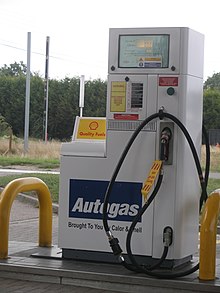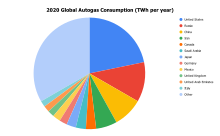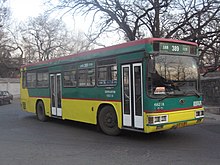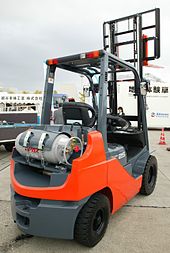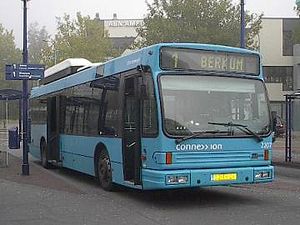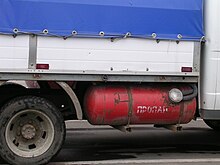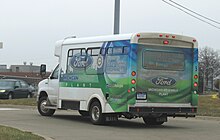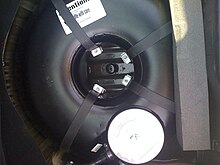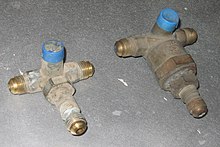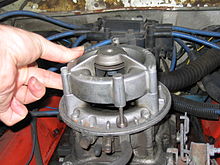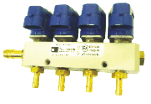Autogas
Approximately half of all autogas-fueled passenger vehicles are in the five largest markets (in descending order): Turkey, Russia, South Korea, Poland, and Ukraine.
In Italy and France, GPL (an acronym for Italian: gas di petrolio liquefatto or French: gaz de pétrole liquéfié) is used.
Despite LPG being widely used as a fuel for cars, motorists in need of autogas can sometimes face difficulties, especially in remote areas and in places where supply and demand are low.
Autogas enjoys great popularity in numerous countries and territories, including: Australia, the European Union, Hong Kong, India, the Philippines, Northern Macedonia, South Korea, Serbia, Sri Lanka and Turkey.
The two main incentives for the government to put this policy into action were to take advantage of the large LPG production and to reduce urban pollution.
[18][19] Whilst historically autogas was excise-free, it began being imposed on all vehicle fuels that were not previously subject to excise in 2011 and was added incrementally up to 2015.
Auto propane demand began to decline in the early 1990s due to changes in technology and relatively low cost of gasoline and diesel fuel.
These conversions are performed in accordance to provincial and territorial regulations and the Canadian Standards Association (CSA) B149.5 – Installation code for propane fuel systems and tanks on highway vehicles.
Damir Stambuk from the Croatian Ministry of Economy, which is also responsible for energy, said that Croatia is not yet ready for a regular autogas market due to a small network of stations, but in the future it will be.
LPG or autogas, despite having existed for about three decades in Greece (initially used only in taxis, in 1999 it was legalized for all vehicles), has become popular in the last three to five years, mostly due to the increase in petrol prices.
It has been re-introduced to Ireland by the new Polish diaspora living in the country drawing upon their knowledge and expertise from Europe's biggest autogas market.
[14] This is why, in 2010, the Japan LP Gas Association started an initiative to encourage corporations and motorists alike to switch to autogas vehicles.
As part of his Think Big policies to encourage energy self-sufficiency, Rob Muldoon heavily subsidised the construction of LPG infrastructure during the late 1970s and early 1980s.
LPG failed to attract attention of the investors and customers due to extremely cheap prices of CNG as Pakistan had huge Natural Gas reserves.
In November 2013 Oil and Gas Regulatory Authority issued about 40 NoC's for setting up LPG Autogas stations mainly to PSO, a State owned Petroleum giant.
The Euronozzle adapter was supposed to replace the current three different LPG filling systems (ACME, Bajonet and Dish) in Europe, but that would be expensive, so investments in such a change-over have not started yet.
The number of autogas vehicles has continues to see high growth,[48] despite a push for operators to switch to NGV (CNG), there has been considerable resistance due to inherent costs.
For that reason, installations are often not made to light and heavy weight trucks, tractors, bus and mini-buses and motorcycles, because the owners of conversion workshops are fearful of the risks.
The reason of this high LPG application is because of the Turkish government's application of high taxes upon petrol and diesel prices, and because of these taxes, Turkey finds itself using the second most expensive petrol in the world (after Norway) even though Turkey has borders with OPEC countries exporting crude oil and petroleum to the world and has the lowest transportation costs.
Technology has reached the point where almost all conversions are 'Sequential Vapour Injection', and in the UK there is a large number of kits[51][better source needed] with various price and quality ranges to choose from, resulting in a very competitive market.
Piston-powered small aircraft that use autogas require a Supplemental Type Certificate issued by the United States Federal Aviation Administration.
Fillers are typically made of brass to avoid the possibility of sparks when attaching or removing the bowser that might occur if steel fittings were used.
The European style of converter is a more complex device that incorporates an idle circuit and is designed to be used with a simple fixed venturi mixer.
Engines with a low power output such as; scooters, quad bikes and generators can use a simpler type of converter (also known as governor or regulator).
The tanks large surface area exposed to the ambient air temperature combined with the low power output (fuel requirement) of the engine make this type of system viable.
In most modern installations, an electronic device called a tachometric relay or safety switch is used to operate electrical shut-off solenoids.
In all installations, there is a filterlock (consisting of a filter assembly and a vacuum or electric solenoid operated shut-off valve) located at the input to the converter.
[citation needed] Because it has 3 main functions: In European style systems, the size and shape of the venturi of the carburettor is designed to match the converter.
[citation needed] The power output capacity of a system is limited by the ability of the converter to deliver a stable flow of vapour.
Even at full output a diesel engine runs about 50% lean of stoichiometric to avoid black smoke production, so there is a substantial amount of oxygen in the intake charge which is not consumed in the combustion process.
